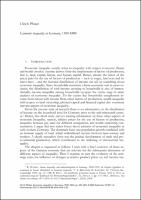Chapter Economic inequality in Germany, 1500-1800
| dc.contributor.author | Pfister, Ulrich | |
| dc.date.accessioned | 2022-06-01T12:11:36Z | |
| dc.date.available | 2022-06-01T12:11:36Z | |
| dc.date.issued | 2020 | |
| dc.identifier | ONIX_20220601_9788855180535_212 | |
| dc.identifier.uri | https://library.oapen.org/handle/20.500.12657/56029 | |
| dc.description.abstract | The chapter reviews existing evidence regarding four aspects of economic inequality: relative factor rents, which relate to the factorial distribution of income and also underlie the so-called Williamson index (y/wus), which is correlated with the Gini index of household income; real inequality in terms of opposite movements of the price of consumer baskets consumed by different strata of society; the inequality of pay according to gender and skill, as well as between town and countryside; and wealth inequality, particularly with respect to the access to land. The main result is that, with given technology and agrarian institutions, there is a positive correlation between population and inequality. | |
| dc.language | English | |
| dc.relation.ispartofseries | Datini Studies in Economic History | |
| dc.subject.other | economic inequality | |
| dc.subject.other | economic history | |
| dc.subject.other | germany | |
| dc.subject.other | pre-industrial age | |
| dc.title | Chapter Economic inequality in Germany, 1500-1800 | |
| dc.type | chapter | |
| oapen.identifier.doi | 10.36253/978-88-5518-053-5.20 | |
| oapen.relation.isPublishedBy | bf65d21a-78e5-4ba2-983a-dbfa90962870 | |
| oapen.relation.isbn | 9788855180535 | |
| oapen.series.number | 1 | |
| oapen.pages | 24 | |
| oapen.place.publication | Florence |

